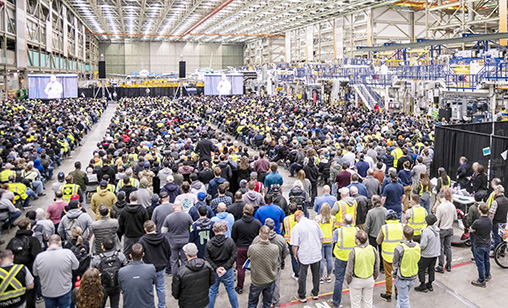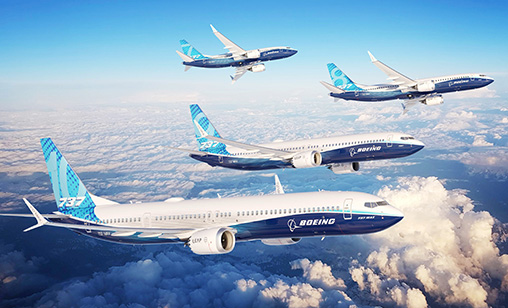Main Story
Boeing’s battle to rebuild customer and passenger trust
Problems continue to plague aerospace giant Boeing as it struggles to rebuild its reputation, particularly its safety culture. The company’s biggest senior management change in years is underway. The new team must establish how much damage has been done to the Boeing brand and then restore confidence in the quality and safety of the aircraft it builds. Associate editor and chief correspondent, Tom Ballantyne, reports.
April 1st 2024
Analysts and aviation industry insiders had been calling for leadership change at Boeing for months, believing a renewal of top management was critical to rebuilding the company’s battered image. Read More » In March their advocacy became reality when it was announced Boeing CEO, David Calhoun, will retire at the end of the year. Previously, he had been expected stay in the job until 2028.
That was not the end of it. Also out, the head of the company’s commercial airplanes unit, Stan Deal. He was replaced immediately by Stephanie Pope, who had been chief operating officer since January 1. Boeing chair, Lawrence Kellner, a former head of Continental Airlines, also announced he would not stand for re-election in May at the company’s AGM.
 |
“It seems they finally caved in to global pressure”, analyst Shukor Yusof, head of Endau Analytics, said. “While many would welcome the much-needed substitution at the top, this has come a tad too late.”
Shukor believes the damage has been done. For many Boeing airline customers, disruption to deliveries is a loss of revenue and opportunity. Malaysia Airlines, as an example, was expecting to accept 10 B737 MAX8s this year, a circumstance now unlikely.
“Moreover, despite these minor and unsurprising rejiggings of executives, I am not convinced there will be a change in attitude. Old (bad) habits die hard. It will take time for genuine change to happen. In the meantime, we can only hope there will not be more mishaps until the end of 2024, when Calhoun is to depart,” he said.
The leadership changes followed another incident involving a B737 MAX. In January, a door panel blew off a Alaska Airlines airplane midair. Then, in April, there was more controversy for Boeing when a whistleblower claimed the company dismissed safety and quality concerns in the production of its B787 and B777 jets. The Federal Aviation Administration (FAA) confirmed it is investigating the allegations.
Boeing engineer Sam Salehpour said he faced retaliation, including threats and exclusion from meetings, after he identified engineering problems affecting the structural integrity of the jets and claimed Boeing employed shortcuts to reduce bottlenecks during B787 assembly.
He alleged these practices could dramatically shorten the life spans of aircraft as they age, potentially leading to catastrophic failures. Boeing halted deliveries of the B787s for more than a year until August 2022 as the FAA investigated quality problems and manufacturing flaws.
In a statement, Boeing said it was fully confident in the B787 Dreamliner and added the claims “are inaccurate and do not represent the comprehensive work Boeing has done to ensure the quality and long-term safety of the aircraft”. It insists extensive testing, overseen by the FAA and inspections of the Dreamliner fleet in service show gaps found in the fuselage joins are not a safety risk.
 |
But Salehpour alleges Boeing used shortcuts to reduce bottlenecks during the B787 assembly process that placed “excessive stress on major airplane joints and embedded drilling debris between key joints on more than 1,000 planes”. Dozens of B787s and B777s are operated by airlines in the Asia-Pacific.
Calhoun, a Boeing director since 2009, took over as CEO in January 2020 following the fatal crashes of two B737 MAX jets in 2018 and 2019. He said the decision to leave at the end of the year was his own and the timing will allow for an orderly transition.
But he has been under increasing pressure and relentless criticism since the Alaska Airlines incident. In a note to Boeing employees, he called the Alaska Airlines blowout a “watershed moment for Boeing” that requires a “total commitment to safety and quality at every level of our company. The eyes of the world are on us. I know we will come through this moment a better company, building on all the learning we accumulated as we worked together to rebuild Boeing over the last number of years”.
Boeing has lost more than $23 billion since Calhoun took over, although most of that is residual damage from the two MAX crashes in Indonesia and Ethiopia. Boeing shares have fallen more than 40% in that time and by some 24% since the Alaska Airlines incident.
And the hits keep coming for the company.
As recently as March, a LATAM Airlines B787 Dreamliner en route from Australia to New Zealand took a terrifying plunge injuring 50 passengers. It was the latest episode in five years of bad publicity for the plane maker. As it happened, the event was reportedly caused by a mistake made in the cockpit and not flaws in the Boeing jet.
The Wall Street Journal, citing unnamed U.S. industry officials briefed on preliminary evidence from an investigation of the incident, said a flight attendant may have mistakenly hit a switch on the pilot’s seat while serving a meal, leading a motorized feature to push the pilot into the controls and push down the aircraft’s nose. The pilot eventually recovered control and landed the plane safely.
While the incident was likely caused by human hands and not a mechanical fault, for Boeing it returned the company to the spotlight; the latest incident in its litany of woes of thelast five years.
 |
Separately, Boeing has been subjected to an extensive audit by the Federal Aviation Administration (FAA) and an investigation by the NTSB.
The findings were damning. According to the FAA, Boeing failed 33 of 89 product audits. It also examined Spirit AeroSystems, the maker of the B737 MAX fuselage that blew out the door panel over Portland. In the Spirit audit, a hotel key card and dish soap were observed being used on a door seal. Boeing has confirmed it is in discussion with Spirit, which it divested nearly 20 years ago, to bring it in-house, a move it hopes will give the company more control over the quality of manufacturing key components.
The FAA found multiple instances where the two companies allegedly failed to comply with manufacturing quality control requirements. It identified non-compliance issues in Boeing’s manufacturing process control, parts handling and storage and product control. In February it released a report on the findings of a review of the safety management processes and effectiveness of these safety management processes within Boeing. In summary, the report acknowledged gaps within Boeing’s safety management and acknowledged a disconnect between senior management and rank and file employees about the firm’s safety vision.
In late February, during an all-day safety discussion at FAA Headquarters, FAA Administrator Mike Whitaker told top Boeing officials the planemaker must develop a comprehensive action plan to address its systemic quality control issues to meet FAA’s non-negotiable safety standards. “Boeing must commit to real and profound improvements,” said Whitaker following the meeting with Calhoun and his senior safety team. “Making foundational change will require a sustained effort from Boeing’s leadership. We are going to hold them accountable every step of the way, with mutually understood milestones and expectations.”
Whitaker told Boeing he expects the company to provide the FAA with a comprehensive action plan by the end of May that will include the steps it will take to mature its Safety Management System (SMS) program. Boeing also must integrate its SMS program with a Quality Management System, which will ensure the same level of rigor and oversight is applied to the company’s suppliers and create a measurable, systemic shift in manufacturing quality control. The FAA has forced Boeing to slow down, capping production of the B737 MAX at 38 jets per month.
 |
So, what impact is all this having on Boeing’s brand and reputation? “Beyond the decline in its stock price, the harm events in the past five years (starting with the two MAX tragedies) have had on Boeing - while not insurmountable - requires a complete overhaul of the company,” says Endau’s Yusof. “Clearly the brand is suffering greatly in the eyes of the public. That said, its MAX jets - as well as the 787 - are still selling well and have the confidence of many top carriers and lessors. This indicates the market has faith in Boeing and the planes it produces, despite the frequent mishaps we have seen since the start of 2024”.
Ratings agency, Morningstar DBRS, also warns the re-emergence of safety concerns at Boeing will materially affect the company, including its ability to make timely deliveries, which is affecting airlines. It says airline growth plans are being slashed because of delivery delays and operational disruptions may occur. These disruptions could result in higher airfares, and decarbonization targets could be affected because of delays in fleet modernization.
“We previously expected the airline sector to continue its growth trajectory, with high single-digit growth in 2024 despite a weaker macroeconomic environment. However, with Boeing’s recent issues as well as existing capacity constraints, that growth forecast may be optimistic,” said Rohit Kumar, Morningstar Assistant Vice President of Corporate Ratings, Diversified Industries.
There is little doubt the MAX problems are having an effect on Boeing production. U.S. airlines have been the worst affected. United Airlines chief executive, Scott Kirby, speaking at a JP Morgan conference, acknowledged the carrier is considering an A321neo order to replace previously ordered 737 MAX 10s, certification of which remains subject to delays.
Speaking at the same conference, Southwest Airlines chief executive, Bob Jordan, cited B737 MAX delivery delays as causing the carrier’s highly constrained 2024 growth plan. “Fix the culture, whatever is at work here. We all need Boeing stronger two years from now, five years from now, 10 years from now. And that takes precedent over delivery delays. Boeing needs to become a better company – and the deliveries will follow that.”
 |
There may be another beneficiary of Boeing’s problem, as well as delivery issues at Airbus. In a March investor report, Morgan Stanley declared Brazilian planemaker Embraer as it’s new “Top Pick” for investors. “We see Embraer as a third Commercial Aerospace player rising to the occasion and breaking into the duopoly of Boeing and Airbus. After decades of investments, Embraer is entering a harvest period,” it said. “As Boeing struggles with aircraft production and delivery, and with Airbus’ backlog already filled until the end of the decade, Embraer is the third commercial aircraft manufacturer rising to the occasion. We expect Embraer to be a beneficiary of commercial aircraft orders in an environment where aircraft demand exceeds supply,” he said.
It said Embraer is poised to thrive in this upcycle because the company has a refreshed portfolio of new products like the E190-E2 and E195-E2 in the commercial passenger jet portfolio, as well as expanded maintenance, repair and overhaul (MRO) services. “Embraer has matured from a niche aircraft manufacturer to a globally prominent diversified Aerospace & Defense company poised to win market share”.
Trade winds are shifting in Embraer’s direction after American Airlines ordered 90 Embraer E175s, with purchase rights for 43 additional aircraft in March this year, says the report. “We highlight that Embraer received more aircraft orders than both Airbus (85 A321neo) and Boeing (85 737 MAX 10) in this announcement, supporting the value that Embraer provides. Even though the E175 is still in the regional jet category and therefore not quite an apple to apples to Airbus and Boeing, the American Airlines order is strategic in that it fills Embraer’s backlog through 2026 and production stability helps Embraer to compete toe-to-toe with the A220/A319neo and the 737 MAX 7 with the Embraer E190-E2 and E195-E2.”
Another emerging threat to the two big planemakers, although not in the short term, is the Commercial Aircraft Corporation of China (COMAC) entry into the single-aisle jet market, the C919. It appeared at this year’s Singapore Air show, and did a promotional tour through the fast-growing aviation markets of Singapore, Vietnam, Laos, Cambodia, Indonesia and Malaysia. At each stop, the Shanghai-headquartered enterprise presented its C919 to potential buyers as a viable alternative to the A320 and B737.
As the C919 tour progressed, COMAC said its goal was to showcase the aircraft and lay “the groundwork for future market expansion in Southeast Asia”. However, the aircraft is certified only by the Civil Aviation Administration of China, which approved it in September 2022. The narrow-body jet entered commercial service with China Eastern Airlines in May last year. COMAC says it has more than 1,000 orders for the C919, but most of those are from Chinese airlines and aircraft lessors. At the Singapore Airshow, COMAC took orders from Tibet Airlines, a Chinese entity, for 40 C919s. China has said it wants to secure broader international recognition for the C919 and plans on pursuing European Union Aviation Safety Agency certification.
Boeing and Airbus don’t appear to be concerned by any potential threat from the Chinese jet. At a media roundtable during the Singapore show, Airbus commercial business chief executive, Christian Scherer, said the C919 is “not going to rock the boat in particular,” adding it was a “legitimate effort” by China but is “not very different” from Airbus and Boeing aircraft.
Dave Schulte, Boeing’s commercial marketing managing director for the Asia-Pacific, said airlines in Southeast Asia may consider ordering C919s, but warned that COMAC will face the same supply-chain disruptions as Boeing and Airbus as post-pandemic demand for air travel increases. Assembled in China, the C919 relies heavily on components, including engines, from companies outside China such as GE and Honeywell International.
Boeing’s road to reputational recovery isn’t going to be a short trip. Even with the major leadership changes it will take lots of time and a great deal of effort to restore public and industry confidence in the brand and a halt to the seemingly endless incidents involving its planes.